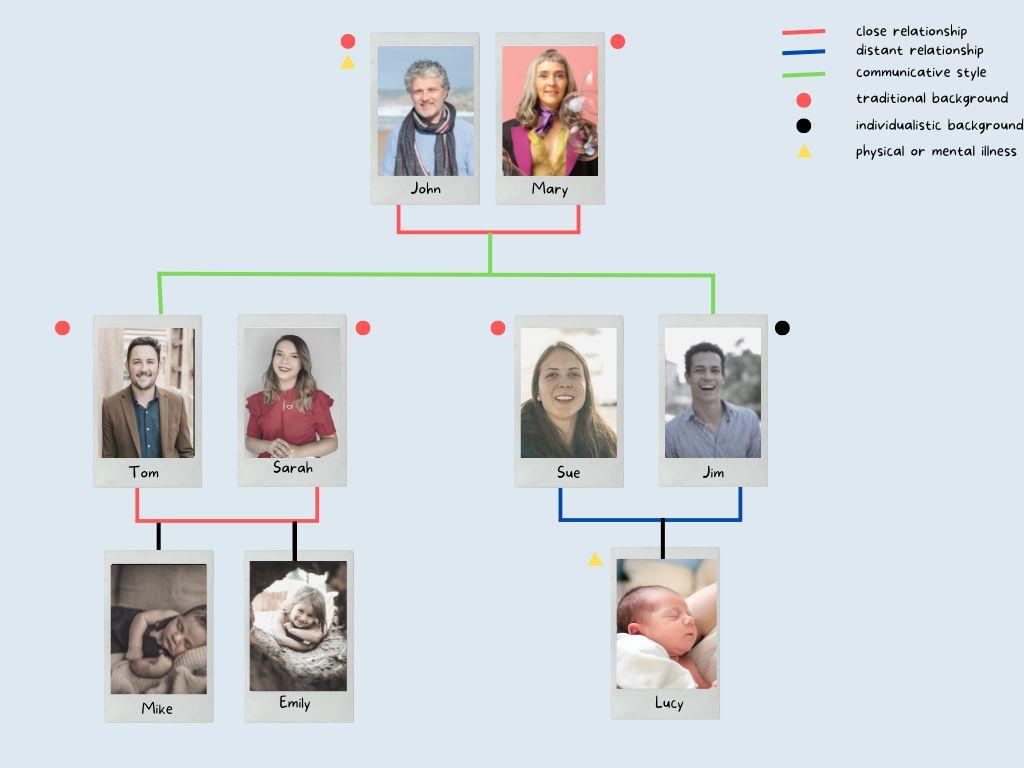Family relationships are complex and multifaceted, with various dynamics at play. A family tree or genogram can be an effective tool to visualize and analyze these relationships. For this essay, I will create a family tree and explore how communication may have been influenced intergenerationally. The family tree I will analyze includes three generations: grandparents, parents, and grandchildren. The grandparents, John and Mary, have been married for over fifty years and have two children: Tom and Sue. Tom is married to Sarah, and they have two children: Mike and Emily. Sue is married to Jim, and they have one child: Lucy.
When we look at John and Mary’s relationship, we see that they have a close and stable relationship, which may have influenced their children’s and grandchildren’s communication patterns. As a long-term and committed couple, they may have provided a model of open and communicative dialogue, supporting their children and grandchildren through the various stages of their lives. Being supportive and non-judgmental facilitated a sense of trust and mutual respect within their family, allowing for effective communication.
Looking at the family tree, we can see that Tom and Sarah have a close and loving relationship, which may have been influenced by the positive example set by Tom’s parents. This may have contributed to a communicative and open environment within their family. They are likely to share their thoughts, feelings, and emotions, creating a strong bond that allows them to support one another in need. As a result, their children, Mike and Emily, may feel comfortable sharing their emotions with their parents, which fosters healthy communication habits.
However, we can also see that Sue’s relationship with her husband, Jim, is distant and possibly strained. This may have been influenced by Sue’s parents, John and Mary, who may have modeled a more traditional, hierarchical communication style. Sue may have internalized this communication style and replicated it in her marriage, which could have contributed to a lack of closeness with her husband. Also, Jim’s individualistic background and communication style may differ from Sue’s collectivist upbringing. These differences may have led to misunderstandings and conflicts, further straining their relationship.
Another factor that may have influenced communication within this family is the presence of serious illnesses. For example, John experienced a severe physical condition in his early years, which may have impacted his communication patterns. As a result of his experience, he may have become more attuned to the importance of open and transparent communication in a relationship. Similarly, Lucy experienced a severe psychological illness in her teenage years, which may have affected her contact with her parents and others. She may feel a sense of shame or guilt around her condition, causing her to withdraw from others or avoid talking about her feelings.
Finally, we can consider how cultural and social factors may have influenced communication patterns within this family. For example, Sarah’s family may have come from a more collectivist culture that values communal harmony and cooperation, which could have influenced how she communicates within her family. On the other hand, Jim’s family may have come from a more individualistic culture that values independence and self-expression, which could have influenced his communication style and contributed to the distance in his relationship with Sue. As a result, they may have different expectations and preferences for how communication should occur within their marriage, leading to misunderstandings and conflicts.
In conclusion, this family tree provides an opportunity to analyze how communication may have been influenced intergenerationally. We can see how positive relationship models, serious illnesses, and cultural and social factors can all shape communication patterns within a family. Understanding these influences helps us better understand the dynamics at play within a family and facilitates better communication and relationships. By identifying potential conflict areas and underlying forces, family members can work towards improving communication and fostering a more supportive and positive environment.
Genogram
